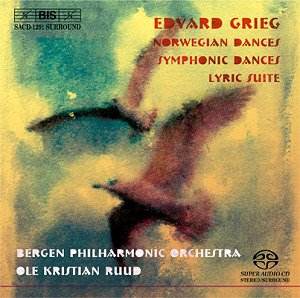The
Bergen Philharmonic is a fine orchestra and they have in the Grieg
Hall a fine acoustic in which the engineers have been able to
achieve something I can by definition rarely say, the finest orchestral
recording I have ever heard. The sound comes from an arc between,
and well beyond, the two front speakers and creates an amazingly
realistic picture of the orchestra from about row G in a concert
hall. Since none of this music is spectacular by nature, the quality
of the recording does not leap out at you immediately, but try
the March of the Dwarfs on a good surround system and you
will know. It is good to be able to praise a recording so extravagantly
on the occasion of the companyís 30th birthday. BIS
has always been in the forefront of recording and has many fine
issues to its name well back into the days of LP. (Remember them?)
It is Robert von Bahrís recording philosophy that he seeks an
"honest sound" from his engineers and that "given
a perfect hall and superb musicians, minimal equipment is enough".
For more read the interview on this site. Well, Robert, this is
certainly as honest as it comes. I have been impressed by several
SACDs in recent months, especially by the San Francisco Mahler
series which until this one arrived, were my benchmark. This one
is an audio event. I shall be very interested to see what the
old guard of reviewers have to say.
Being
a reviewer has one disadvantage, one cannot leave well alone.
In the case of this issue, this meant asking questions about the
tempo in the final Symphonic Dance. That led me to listen
to a recording of the same repertoire on Dutton CDSJB 1012 with
Barbirolli and the Hallé Orchestra. Comparisons being odious,
let me dispose of the comparison quickly. Listen to the Bergen
performances and you will undoubtedly not regret your purchase
and in one particular respect you will have bought the best there
is. Listen to the Barbirolli and ignore the common-or-garden-variety
recordings from the 1950s, 1960s and 1970s (quite easy), and you
will hear this music moulded by a musician of genius into something
of the greatest beauty. Ideally, buy both because, as noted above,
the present disc has something special to offer.
Ole
Ruud has been in charge of various Norwegian and Swedish orchestras
since the early 1980s and has won several prizes for his contributions
to the spread of the rich Scandinavian orchestral repertoire.
He makes much of the cascading strings in the Shepherd Boy
movement of the Lyric Suite and urges the oboist in the
Allegro grazioso 2nd movement of the Symphonic
Dances into some really elegant playing; lovely stuff! Griegís
dances are all so very attractive that a smile is bound to appear
as you listen to this lovely SACD. The Lyric Suite is fairly
regularly recorded but the Norwegian Dances and Symphonic
Dances get fewer outings than they deserve. Grieg was apparently
none too pleased about Hans Sittís orchestration of the former,
but they sound very well and could easily pass for echt
Grieg. In the Symphonic Dances Grieg wrote his most attractive
symphony. They are much larger in scale than the more famous dances
from Peer Gynt and invite just the sort of serious exploration
given by Ruud. He takes nearly 34 minutes over them, compared
to Barbirolliís brisker 29.40. Most of that extra is in the first
dance where his Allegro is perhaps too moderato.
Elsewhere Ruud directs this gorgeous music with loving care and
allows his fine band to play at their very best. It is all very
satisfying. Wise demonstrators should see to it that this BIS
disc is in constant use to show off the finest HiFi equipment
and put a smile on the face of customers.
Dave
Billinge
